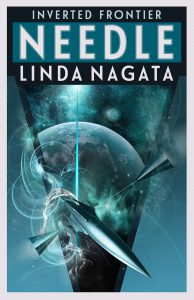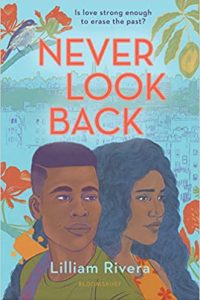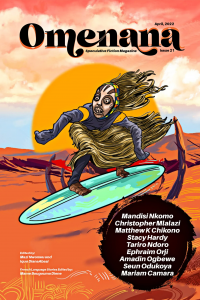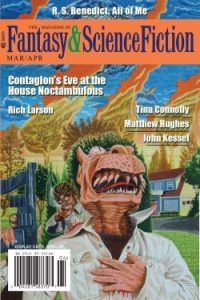Russell Letson Reviews Needle by Linda Nagata

Needle, Linda Nagata (Mythic Island 978-1-937197-40-7, $19.00, 356pp, tp) July 2022. Cover by Sarah Anne Langton.
Decades ago, my imagination of the far, far future of humankind was formed by Olaf Stapledon’s Last and First Men and Star Maker: melancholy, long-lens scenarios that lack individual characters and conventional plot-lines but whose visions of the possible range of thinking beings and civilizations and deep time were simultaneously breathtaking and sobering. Relatively recent inheritors of this narrative-conceptual space include Iain M. Banks, Stephen Baxter, Gregory Benford, Greg Egan, Robert Reed, and Karl Schroeder, and their motifs and tropes range from space operatics, to nanotechnology, to the post-human condition, to what might be called cosmology opera.
Linda Nagata’s work fits neatly into this extended family. Her early Nanotech Succession novels Deception Well (1997) and Vast (1998) are set millennia after the ruination of a network of already-ancient human interstellar civilizations. Crucial to this collapse are leftovers from a universally destructive conflict of 30 million years earlier: the autonomous warships of the long-vanished Chenzeme, operated by fanatical artificial intelligences wielding planet-busting weapons. Now Nagata has returned to this setting in a new series, Inverted Frontier, in which the story movement is not outward but inward, as a band of adventurers journey from a safe refuge out beyond the fringes of human expansion, to discover what became of the now-extinct “Hallowed Vasties,” civilizations that had rebuilt their solar systems into light-blocking Dyson swarms of orbiting structures.
In Edges (2019), the wandering adventurer Urban returns after a thousand-year absence to Deception Well in charge of Dragon, a co-opted and repurposed Chenzeme “courser,” and recruits a crew for his inward voyage of discovery. One early encounter is with the damaged but dangerous godlike being Lezuri; and in Silver (2020) they find Vertilotus, the nanotech-haunted, ever-changing, living-dreaming ringworld portrayed in Memory (2003), where they pick up one of its central characters, the young man Jolly, who spent many years inside the nanotech/computational stratum called the “silver.”
In Needle, the expedition heads for the apparently ruined Tanjiri system, which may host another godlike entity. On the way, Urban hopes to find the means to open the Needle, a tempting (but perhaps Faustian or boobytrapped) gift from Lezuri, “a mystery that more than ever, Urban was anxious to solve” for its promise of knowledge and power. At Tanjiri, the Dragoneers must deal with two sets of marooned humans, the descendants of refugees from another system ruined by a subtle Chenzeme weapon, who have their own troubled history to overcome. The Tanjiri system harbors even stranger secrets on a pristine living planet and a strange, apparently artificially created moon where there should be nothing at all.
The crew faces a set of interlocking challenges: the situations of the refugees; the puzzle of a living world where there should only be Chenzeme-wrought devastation; the riddle-promise-threat of the Needle; and the internal tensions and conflicts generated by dealing with these problems. This last is a serious matter, since even though Urban is the originator of the expedition, the crew is actually a community dedicated to consensus, and Urban’s sense of leadership and drive for knowledge must contend with the caution – and other, equally strong drives – of some of his companions.
Much of the novel’s appeal is in the array of thinking entities that make up the cast. Some are virtual persons spun off from the natural (I’ll come back to that) humans of the crew: ghosts (full copies) and Apparatchiks (specialized versions of their originals with sharply focused abilities and interests) that exist only as computational entities. DIs – Dull Intelligences – are functional artificial intelligences with just enough sentience and flexibility to operate equipment and carry out tasks. Dragon itself possesses awareness, a fierce and paranoid urge to destroy any non-Chenzeme life, and operating the ship requires arguing its hive-like mental community into a consensus.
Even the original, natural humans are actually post-human, with neurological-computational enhancements and fluid physical, emotional, and intellectual natures. The physical embodiment of an individual – the avatar – is resilient, repairable, and widely reconfigurable, as is the person’s core personality. Crew member Vytet, for example,
[f]or many years… had been comfortable within a body of mixed gender, neither man nor woman, but with aspects of both. Many times in her life that form had given her such a sense of freedom. It was as if, by provoking the question of what she was, she could liberate herself from the tedious default answers implied by every social interaction, every tryst, every history she read….
It is Vytet who spins off an Apparatchik designed to solve the puzzle of the Needle, and gives the Apparatchik an unprecedented degree of individuality and freedom, “to endow it with a mind more flexible than [her] own.” The result is a new being who sees herself as a completely distinct entity, the Cryptologist. This entity’s very existence is a source of discomfort for members of a culture that “had chosen to remain human… and had long ago rejected the creation of true artificial intelligences, or of artificial beings.” This discomfort is only increased when the Cryptologist manages to build herself an avatar body and join the community in the physical world while not giving up her defining purpose – her built-in obsession – to open the Needle. And her closest ally is the other outsider, Jolly, who still carries within himself the silver of Verilotus.
Even though nanotechnology is arguably (historically, at least) outside the Matter of Stapledon, the idea has become an important speculative explanation for a range of near-magical technologies associated with that vision. Here it is not only an enabling device for the various expansions of human bodies and minds but, in its incarnation as the silver, a way of animating nature itself, of generating a world that has agency and internality – that is, mind. In this, it recalls Greg Bear’s Blood Music, or the protean, reactive worlds of Karl Schroeder (Ventus) and Kathleen Ann Goonan (the Nanotech Quartet) – the opposite of the “gray goo” nightmare of universal deliquescence (though Memory and Silver do portray something of that chaotic dark side).
Each new book in these sequences expands the series’ thematic horizons. Where Edges and Silver were exploratory, journeying out across space and in to the realm of the silver, Needle is driven as much by social and psychological tensions as by physical travel and conflict. Expedition members, refugees, and colony builders navigate ethical mazes and confront ancient conflicts and fears while unraveling new puzzles. The story builds toward a satisfyingly dramatic cinematic climax, but that sequence is the resolution of a set of psychological and philosophical conflicts and opens metaphysical doors through which further volumes will proceed. As the Cryptologist’s (certainly thematic) curtain line puts it: “we are all captives of our curiosity.”
Russell Letson, Contributing Editor, is a not-quite-retired freelance writer living in St. Cloud MN. He has been loitering around the SF world since childhood and been writing about it since his long-ago grad school days. In between, he published a good bit of business-technology and music journalism. He is still working on a book about Hawaiian slack key guitar.
This review and more like it in the August 2022 issue of Locus.
 While you are here, please take a moment to support Locus with a one-time or recurring donation. We rely on reader donations to keep the magazine and site going, and would like to keep the site paywall free, but WE NEED YOUR FINANCIAL SUPPORT to continue quality coverage of the science fiction and fantasy field.
While you are here, please take a moment to support Locus with a one-time or recurring donation. We rely on reader donations to keep the magazine and site going, and would like to keep the site paywall free, but WE NEED YOUR FINANCIAL SUPPORT to continue quality coverage of the science fiction and fantasy field.
©Locus Magazine. Copyrighted material may not be republished without permission of LSFF.







